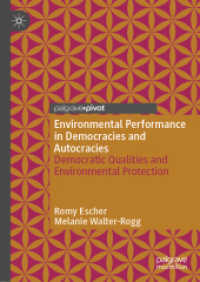Full Description
The authors are proud sponsors of the 2020 SAGE Keith Roberts Teaching Innovations Award—enabling graduate students and early career faculty to attend the annual ASA pre-conference teaching and learning workshop.
Changing Contours of Work is an exploration of the American workplace in the larger context of an integrated global economy. Presented with engaging vignettes and rich data, this Fourth Edition shows the reader how the "old economy" is now operating within the "new economy" and how that integration shapes the development of work opportunities.
Authors Stephen Sweet and Peter Meiksins use an international comparative perspective, revealing the historical transformations of work and identifying the profound effects that these changes have had on lives, jobs, and life chances. This text supports the reader's understanding of the origins of current problems confronting working people in the new economy, and contributes to a much-needed dialogue about the strategies for liberating workers from poverty, drudgery, discrimination, stress, and exploitation.
Contents
List of Exhibits
About the Authors
Preface to the Fourth Edition
Acknowledgments
1. Mapping the Contours of Work
Scenes From the New Economy
Culture and Work
Structure and Work
Class Structures
Job Markets and Job Demands
Demography and the New Labor Force
Agency and Careers
Conclusion
2. New Products, New Ways of Working, and the New Economy
A Postindustrial Society?
The End of Mass Production?
New Skills?
Interpersonal Skills in the Workplace
High-Tech Work
New Cultures of Control?
Technological Change and a Jobless Future?
Rigid Jobs or Flexible Jobs?
The End of Organized Labor?
A New Global Economy?
Conclusion
3. Economic Inequality, Social Mobility, and the New Economy
Are Economic Divides Narrowing or Widening in the United States?
Are Career Pathways Opening or Closing?
Missing Rungs in the Ladder
Entry Points: Securing the Good Job in Young Adulthood
Exclusion Owing to Criminal Conviction
Is the Global Economy Becoming More Flat or Bumpy?
Conclusion
4. Whose Jobs Are Secure?
Risk and Work: Historical and Comparative Views
How Insecure Are Workers in the New Economy?
The Costs of Job Loss and Insecurity
Old and New Careers
Risk, Well-Being and Retirement
The Dawn of the Gig Economy
Conclusion
5. A Fair Day's Work? The Intensity and Scheduling of Jobs in the New Economy
Time, Intensity, and Work
How Much Should We Work? Comparative Frameworks
Why Are Americans Working So Much?
Nonstandard Schedules: Jobs in a 24/7 Economy
How Americans Deal With Overwork
Conclusion
6. Gender Chasms in the New Economy
When Did Home Work Become Nonwork?
Women's Participation in the Paid Labor Force in America
Gender Inequalities in Compensation
Socialization, Career Selection, and Career Paths
Interpersonal Discrimination in the Workplace
Structural Dimensions of Gender Discrimination
The Devaluation of "Women's Work"
How Job Designs Discriminate
Strategies to Bridge the Care Gaps: International Comparisons
Conclusion
7. Race, Ethnicity, and Work: Legacies of the Past, Problems in the Present
Histories of Race, Ethnicity, and Work
African American Exceptionality
The Immigrant Experience
Magnitude of Racial Inequality in the New Economy
Intergenerational Transmission of Resources
Race, Ethnicity, and Economic Capital
Race, Ethnicity, and Human Capital
Race, Ethnicity, and Social Capital
Race, Ethnicity, and Cultural Capital
Geographic Distribution of Race and Work Opportunity
Racial Prejudice and Discrimination
Racialized Jobs
Race, Ethnicity, and Work: Social Policy
Organizational Strategies
Affirmative Action
Immigration Policy
Conclusion
8. Reshaping the Contours of the New Economy
Opportunity Chasms
Class Chasms
Gender Chasms
Racial and Ethnic Chasms
International Chasms
Agents of Change
Individuals
Activist, Advocacy, and Interest Groups
Unions and Organized Labor
Employers
Government
International Organizations and International Controls
Conclusion
Appendix: Legislative and Regulatory Time Line of Worker Rights and Protections in the United States
References
Index







